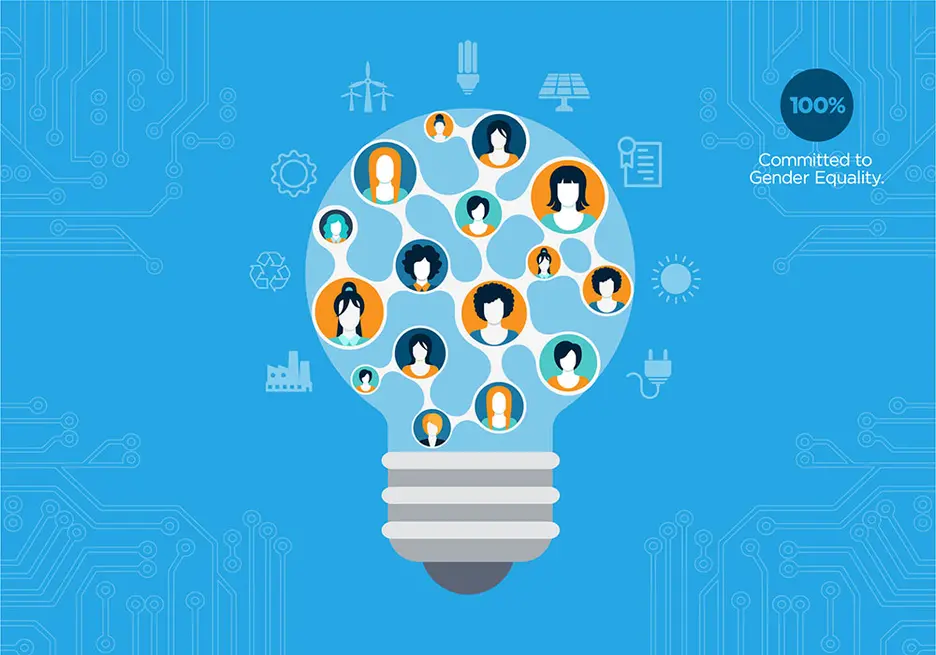Three best practices for energy companies investing in women

Three years ago, Marie-José Nadeau took the helm as the first woman to chair the World Energy Congress in its 90-year-history. She cautioned that the energy business was at a critical stage, suffering from underperformance and facing disruptive change. In her view, the industry would not have the ability to innovate and tackle these challenges without gender diversity.
At the time, only 4% of executive board members at the top 100 utilities companies were women. Today, this number has inched up by only 1%, according to EY’s 2016 Women in Power and Utilities Index. At this rate, it would take the power industry four decades to reach 30% of women participation in boards.
[clickToTweet tweet="At this rate, it would take the power industry 4 decades to reach 30% of women participation in boards" quote="At this rate, it would take the power industry four decades to reach 30% of women participation in boards" theme="style1"]
At the employee level, a handful of energy companies in Latin America and the Caribbean are starting to invest in recruiting and training female personnel in non-traditional roles, for example, installing solar panels in remote areas and changing LED public lighting in cities.
As renewable energy scales up across the region, technical jobs in solar and wind will be in high demand. Energy companies will have to widen their talent pool to meet this need. Here are three ways energy companies are already investing in opportunities that benefit men and women:
1. Investing in gender certifications
Gender certifications today are what LEED certifications were a decade ago —a third-party seal of approval for sustainability— and some companies in Latin America are already investing in them. Based in Switzerland, global certifier EDGE (Economic Dividends for Gender Equality) is increasing its presence in Latin America and the Caribbean. Another option is seeking certification at the country level. These type of gender certifications allows companies to map and benchmark their efforts to create, support and advance gender equality throughout the workplace.
In Mexico, this was the route that an energy service company took to start transforming its corporate culture. Based in Monterrey, Óptima Energía works with cities to replace incandescent street lights with energy-efficient LED street lamps. Two years ago, Óptima Energía embarked on a gender certification program through the Mexican Standards for Labor Equality and Non-Discrimination. Investing in a gender certification is just one of many steps this company is taking to ensure an equitable and inclusive workplace that attracts the best employees.
2. Partnering with technical universities to train new talent
The solar industry is growing exponentially in Latin America and the Caribbean, and demand for experienced solar technicians is outstripping supply of qualified people. The same is true for the wind sector. With nearly two million people employed in renewable energy jobs, the need for a steady pipeline of qualified talent is opening doors for women.
In the last five years, Uruguay has become a powerhouse wind producer, steadily moving away from relying on fossil fuels and hydropower. Solar is now ramping up. In 2015, the energy companies Technova and Sky Solar started installing solar panels in Paysandú, a small city in Western Uruguay on the Argentinian border. The companies wanted to hire locally, and partnered with Universidad del Trabajo (UTU) and Instituto Nacional de Empleos y Formación Profesional (INEFOP) to train local personnel in the assembly of solar photovoltaic projects. They set a target of 40% female participation in their programs and met their goal.
3. Recruiting women in STEM fields
In Latin America, 45% of scientific researchers are women, surpassing even the global average; yet, women are vastly under-represented in science, technology, engineering and mathematics (STEM) fields. Cultural and socioeconomic barriers often lead young women to drop out of school to meet traditional obligations like care giving.
In Panama, Grupo Ecos invested in an internship program targeting female students on STEM and finance tracks for the Divisa Solar project, the first utility-scale solar park in the country. Financed by IDB Invest (formerly known as Inter-American Investment Corporation) and the Canadian Climate Fund for the Private Sector in the Americas (C2F), Divisa Solar is changing the conversation around traditional gender roles while benefitting local women professionals.
Empowering women makes business sense
The evidence is clear —greater gender diversity drives business success. As the renewable energy boom in Latin America leaps ahead, investing in opportunities for women professionals will be critical for energy companies to stay ahead of the curve. Alison Kay, EY global vice-chair of industry, put it in these terms: “In these times of disruptive change, as the sector undergoes fundamental transformation, diverse leadership teams make good business sense.”
LIKE WHAT YOU JUST READ?
Subscribe to our mailing list to stay informed on the latest IDB Invest news, blog posts, upcoming events, and to learn more about specific areas of interest.
Subscribe




